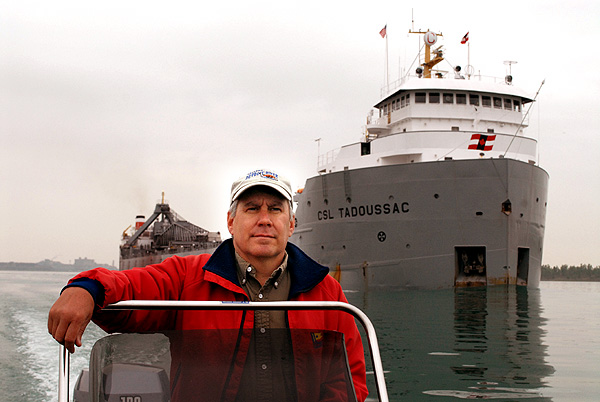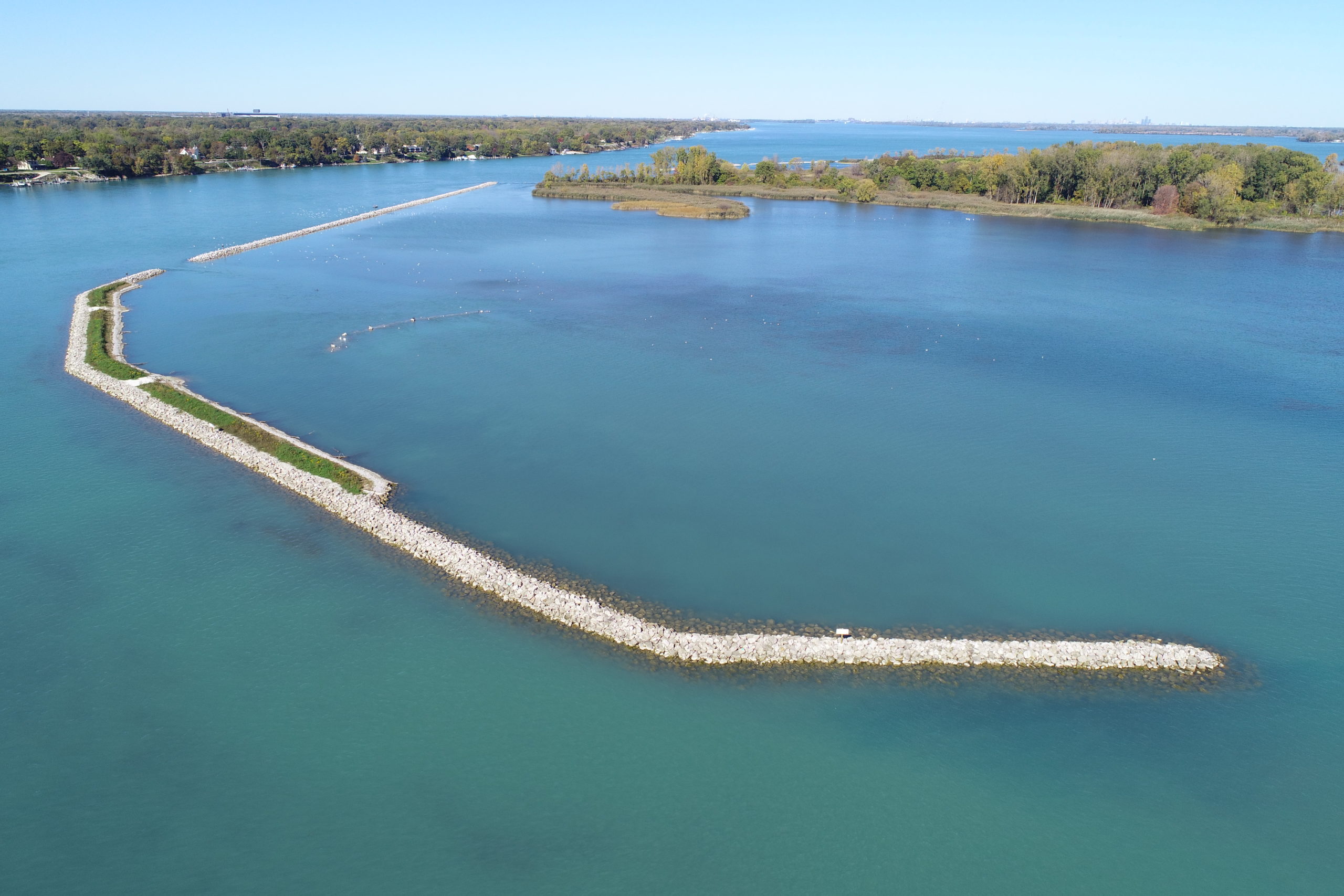Detroit Riverkeeper is Helping Reverse Decades of Unregulated Pollution
By: Thomas Hynes

The Detroit River is a crucial strait in the Great Lakes system, connecting Lake Erie with Lake Huron by way of the St. Clair River and Lake St. Clair. The 32-mile river runs in between the city of Detroit and Windsor, Ontario, making it an international boundary and important economic route. This strategic positioning gave birth to the city of Detroit. It would also lead to several decades of unregulated pollution.
As the city of Detroit and its suburbs grew, so did its population and its economic activities. Fort Detroit, as it was known in the 1700s, was home to fur trading, then shipbuilding, and eventually heavy industry, earning Detroit its nickname as the Motor City. All this growth and activity reshaped the landscape and affected the local environment, including very real downstream effects in the Detroit River.
“Depending on what the industry was, it could be anything from PCBs to mercury to dioxin to who knows what. And now with emerging contaminants like PFOBs, we’re out there doing testing and sampling to see how pervasive that is in the environment,” says Robert Burns, the Detroit Riverkeeper. “All our drinking water comes right out of the Detroit River. So anything that goes in the water upstream from us is going to affect us.”

Burns sees legacy contaminants, the layers of material sediment that have built up over the last 300 years of urbanization and industrialization that now sit on the river bottom, as the biggest obstacle facing the Detroit River.
Friends of the Detroit River, home to Detroit Riverkeeper, has been working on reversing the effects of this water pollution since their founding in the early 1990s. In the early 2000s, a board member attended a Waterkeeper Alliance conference in New York City, came back and reportedly said, “This is a group we should be involved with.” And so in 2003, Detroit Riverkeeper was born. Burns was appointed the first Detroit Riverkeeper that same year, a position he still holds today. Burns grew up along the river, and spent a lot of time on or near the water going hunting, fishing, camping and otherwise exploring all the natural wealth the area had to offer. He cites the World War II era as the ecological turning point for the area.
“Detroit called itself the arsenal of democracy in the 1940s, producing all the goods for World War II. It was the birthplace of the assembly line and heavy production. There were steel mill operations and chemical concerns,” says Burns. “We really took a beating when it came to pollution and certainly sediment contamination over the years. That’s something we have been working on.”
An unforgettable moment in the local conservation movement came later in the 1940s, after an oil spill killed thousands of migrating ducks in the Detroit River. Local hunters collected the dead ducks and left them on the lawn of the State Capitol in Lansing.
Environmental quality and oversight has improved in the decades since. But there are still plenty of threats facing the Detroit River watershed. The problems are common to most urbanized areas. Combined sewer overflow is a major concern, typically every time it rains. Detroit, like a lot of American cities, combines their storm water and sewage. So any time it rains, the system gets backed up, forcing untreated sewage to find its way to the open water.
“We’re getting more wet weather,” says Burns, referring to changes in weather patterns due to climate change. “Call it what you want, but there’s a definite measurable trend of more and more precipitation which creates load on the system.”
Dealing with the legacy sediment from all the factories and industry that once lined the Detroit River is probably the biggest obstacle facing Detroit Riverkeeper. Until that’s resolved, the watershed will still be listed as an Area of Concern by the U.S. Environmental Protection Agency and the U.S.-Canada Great Lakes Water Quality Agreement.
Still, the water quality has improved. The municipal wastewater facilities are doing a better job of treating their waste before discharging it. A big help in this effort came by way of the Great Lakes Restoration Initiative in 2009. This Act of Congress allowed for increased funding, which let groups like Detroit Riverkeeper receive grants through the EPA, and other agencies, to more aggressively restore habitat and other forms of environmental remediation.
Of all the projects Detroit Riverkeeper has undertaken, Burns says his favorite is the work done on Stony Island, a 52-acre uninhabited island toward the southern end of the river. The island had suffered decades of erosion, which greatly reduced its wetlands. Restoration began in 2013. Rock shoals were installed around the island, as was habitat supporting vegetation. The plan also included 50 acres of backwater, a calm water zone ideal for fish spawning. On land, turtle nesting areas and snake hibernacula were constructed.

“I grew up just across the river from this island, spent a lot of time hunting, fishing and exploring it as a kid. I saw firsthand the loss of wetland habitat and wildlife that occurred to this place from the effects of pollution,” says Burns. “I feel I have come full circle in being able to give back to a place that was so instrumental in developing my love of the river.”
Though it may have seemed like a longshot just a few decades ago, the Detroit River presents a tremendous amount of recreational opportunities. Burns says that the river probably has the best walleye fishing anywhere in the world. And there’s also ample area for boating, kayaking, and swimming.
A lot of this activity is in the more residential and undeveloped areas near the southern end of the river. But there is also increasing activity up near the city of Detroit too, including Belle Isle, which sits in the middle of the river and is managed as a Detroit city park.
“If you would have been here 15 or 20 years ago, we had brownfields, we had industry, we had old warehouses. It’s all gone now. It’s all open parks, and walkways, and bike paths. Now we’re starting to see some residential properties, eateries, and other things going on,” says Burns.
“One thing that we’re working on is trying to connect with people who don’t consider the river to get out there. We called it building stewardship.”
There’s a lot of reasons to celebrate the recovery of the Detroit River from pollution. There’s also plenty of reasons to be hopeful for the future, especially, as Burns points out, if funding continues to flow from the federal government. An infrastructure bill from Congress would also be a welcome development for the Detroit River.
As Burns says, “We’ve done a lot. But there’s still a lot more to do.”
The future of the Great Lakes depends on activists like you calling for drinkable, fishable, swimmable water for future generations. We need your voice to ensure that this vision for the lakes becomes a reality. Sign up here or below to get more information from the Great Lakes Waterkeepers and learn more about how you can take a stand for our Great Lakes!
This post was made possible thanks to funding from the Swarovski Foundation.